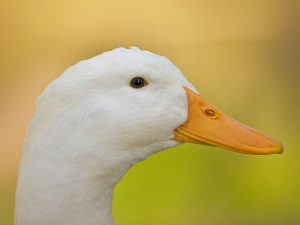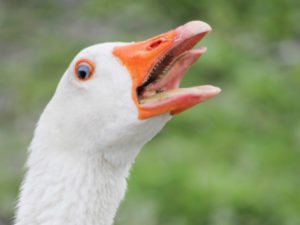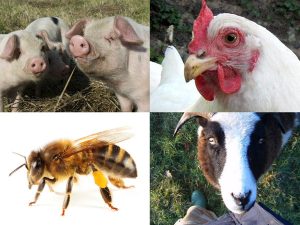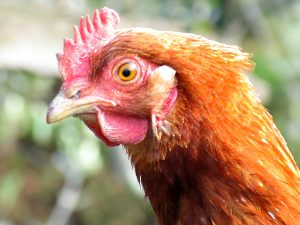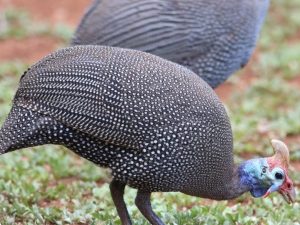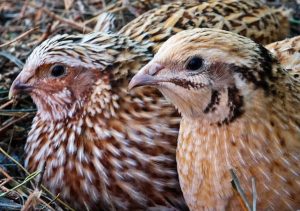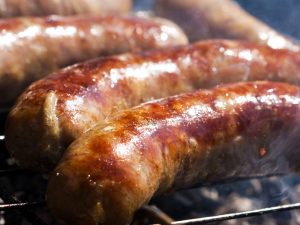Turkeys - introduction
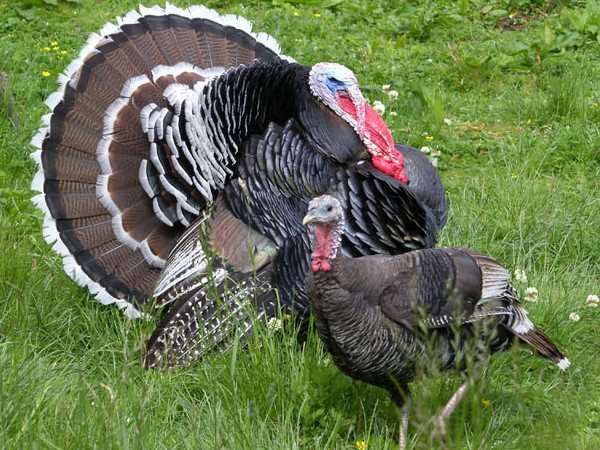
“Turkey is undoubtedly one of the best gifts that the New World has made to the Old.” – Jean Anthelme Brillat-Savarin
Contents
What are turkeys?
Domestic turkeys are large fowl, descended from the wild turkey (Meleagris gallopavo) of Mexico and domesticated around 2,000 years ago. Turkeys are kept for their meat, most often to supply the Christmas market, especially in the UK, US and Canada. Striking birds, they have bald heads and fleshy protuberances above and below the beak. Mature males (‘stags’) in particular, have beautiful plumage with large tail feathers and will spend a considerable amount of their time displaying to any females who may be nearby.

Turkeys are highly social birds: they naturally live in single-sex flocks of related birds, up to 20 per flock. They form strong bonds within these flocks and will become aggressive with any intruders. Their preferred habitat is dense woodland, or other vegetation, interspersed with open areas. Like chickens, they are omnivorous, their natural diet consisting of plant material, insects and even small mammals and reptiles.
Most domestic turkeys kept today are raised intensively indoors. The stocking densities and the flock sizes lead to a number of welfare concerns. In particular, turkeys in these conditions cannot form their natural stable social relationships – aggression increases, with birds often injuring each other.
What are the benefits of keeping turkeys?
Turkeys are not difficult to keep if you have sufficient space, and they are entertaining birds with plenty of personality. They are some of the most decorative productive fowl you can have around; the displaying stags are particularly striking.
If you like to eat turkey at Christmas, or any other time, you can ensure the turkey you are eating is a healthy, slow-growing breed, allowed to free range in a natural flock. You can also reduce food miles and play your part in preserving an endangered breed. If you have a smallholding you may be able to gain an income stream producing ethical, sustainable turkey for the Christmas market.
While turkeys are not prolific egg layers they do lay around 2 eggs a week. Their eggs are similar in size and composition to duck eggs – they are rich, and excellent for baking with.
Turkeys can, like chickens, provide some pest control in the garden, as they have a taste for insects. However, they will scratch up, eat and trample your vegetables if allowed unrestricted access.

What can I do?
Getting started
There are 10 standard breeds of turkey in the UK. These breeds are slower growing than the commercial, double-breasted turkeys but this means they are healthier, hardier and able to move more freely. The main breeds used for meat production are the Norfolk Black, the Bronze and the Bourbon Red. The smaller, more ornamental breeds can also be used to produce meat and need slightly less space. Some of these breeds produce more eggs, and some can be kept as ‘broodies’ as they make good mothers.
You can buy ‘poults’ (young turkeys) from a day old, though you would need to provide them with a heat lamp or plate until they are at least 6 weeks old. You can buy 6-week-old ‘off heat’ turkeys at slightly more expense, or adult breeding stock.
Buying fertile eggs is also an option, particularly if you can’t source the breed you want. Incubating and hatching eggs is not hard to do with a little research. You will need to buy an incubator and a heat lamp. You’ll also need an indoor space for the poults until they are ready to go outside, although this could be a draught-proof shed.
Introducing a new turkey to a flock can be a difficult and slow process due to the strong bonds between flock mates, and the tendency to gang up on outsiders. If possible, buy your whole flock together. If you must introduce new turkeys it’s better to add two at a time rather than a single turkey.

Housing
Opinions vary as to how much outdoor space turkeys need. They are curious animals that need to be able to express their natural foraging behaviour; the space provided must allow for this. A trio can easily be kept in a large garden. Ideally turkeys should also be provided with trees, shrubs or some sort of artificial cover in their outdoor area.
Turkeys need shelter at night in well-ventilated housing, secure from predators. A pair of turkeys should have at least 1.5m² of floor space, more for stags. For a small flock, a small garden shed is often ideal. A perch of around 8cm diameter, 75cm off the ground should be provided. For large breeds especially, it’s a good idea to provide a soft landing below the perch, with a deep bed of shavings for example.
Stags tend not to fly but hens have been known to, even over a 2m fence. The larger the area turkeys have to roam in, and the more interesting it is for them, the less likely they will fly out of their enclosure. If you need to contain your turkeys you may find a 1m high fence is enough deterrence; on the other hand, you may find some hens get into the habit of flying over even a much higher fence.

Feeding
The simplest way to feed your turkeys is to give them commercially-produced compound food. These feeds are labelled ‘starter’ (for poults up to 8 weeks), ‘grower’ (up to 18 weeks) and ‘breeder’. Soya-free and organic feeds are available. At the starter and grower stages it’s important to be aware that turkeys require higher levels of protein than other poultry and therefore must be fed pellets specifically formulated for turkeys.
With a little research it’s possible to mix your own feed using grains, legumes, seeds and meal worms. This can be a way to reduce food miles and avoid ingredients you consider unsustainable. Some sources do not advise doing this, suggesting you may not provide your birds with the carefully balanced diet they need; however, many people do so with apparent success. Mixing your own feed is more likely to be a good option if your turkeys have the opportunity to range freely and forage as well.
Turkeys should be provided with grit and have access to clean water at all times. You may also want to give your turkeys some oyster shell if they are laying.

Health
Turkeys, like chickens, need a dust bath to help them control external parasites such as lice and mites. You can either provide a box full of dry soil and sand, or a covered area where they can dig their own dust bath. Either way, the dust bath must be protected from the rain so your birds can use it in all weathers. Adding diatomaceous earth to the dust bath can help protect your turkeys from parasites. If your birds do suffer from lice or mites you can add lice powder to their dust bath – this is far more effective and less stressful than trying to apply it directly yourself.
Red mite can be a particular problem in turkeys, as the mites live in the shed and attack the turkeys at night. You can prevent and treat red mite by regularly cleaning the shed with a pressure washer, special detergent and/or a steam cleaner. Pay special attention to cracks and crevices. Afterwards you can dust the house with diatomaceous earth or a mite powder (organic products are available). Plastic houses do not provide the same hospitable habitat for the mites as wooden ones, and are worth considering if you are struggling to control the red mite.
Blackhead is a disease caused by a parasitic worm and can be a serious problem for turkeys. The first sign is bright yellow diarrhoea and you should contact your vet if you see this. To prevent blackhead:
- don’t keep turkeys with chickens
- don’t keep turkeys on land previously occupied by chickens, or by a turkey flock previously affected by blackhead
- use pasture rotation to reduce the parasite burden on your pasture
- worm your turkeys every 3 months with Flubenvet
For most poultry it is possible to reduce or eliminate chemical wormers – thus avoiding contributing to the problem of resistance to medications – by using good pasture management and ‘faecal egg counts’. Unfortunately, this cannot be recommended with turkeys due to the seriousness of blackhead.
As with all livestock, check your flock every day and find a good vet who can be contacted in an emergency.

Meat production & slaughter
It is legal to slaughter turkeys at home for consumption by yourself and your immediate family provided it’s done humanely. Turkeys, however, are more difficult to dispatch than smaller poultry and there are more restrictions on the methods that can be used, particularly for birds over 5kg. See the Humane Slaughter Association for more information. It’s advisable to get training and the help of an experienced person if you wish to slaughter the birds yourself at home.
For the smallholder, supplying small numbers of birds directly to consumers or to local retailers, it’s also possible to slaughter and process your birds on-farm, although you must register with your local authority. The Humane Slaughter Association is a good source of information on methods, equipment and courses to attend.
If you plan to produce meat for sale and you slaughter the birds yourself, or send them to a slaughter-house but take on the butchery yourself, you will need to follow hygiene regulations and have your premises inspected by Environmental Health on a regular basis. Contact the Food Standards Agency for further information.
Paperwork and regulations
You have to register with DEFRA and standard regulations apply if you keep more than 50 birds (including other types of poultry). There are no regulations for people keeping fewer than 50 birds other than the general rules and regulations covering animal welfare.
Specialist(s)
Thanks to Lesley Anderson of Permaculture Scotland for information; main image by Idalia Skalska, creative commons.
The specialist(s) below will respond to queries on this topic. Please comment in the box at the bottom of the page.
 Hannah Thorogood has an MSc in organic farming, and is a senior tutor in the British Permaculture diploma system. She runs her 1 woman 100acre organic farm The Inkpot in Lincolnshire, using regenerative farming methods. She has raised turkeys for the last 8 years, winning National Great Taste Awards for them. They mob graze around the 3000 young trees, foraging and free roaming.
Hannah Thorogood has an MSc in organic farming, and is a senior tutor in the British Permaculture diploma system. She runs her 1 woman 100acre organic farm The Inkpot in Lincolnshire, using regenerative farming methods. She has raised turkeys for the last 8 years, winning National Great Taste Awards for them. They mob graze around the 3000 young trees, foraging and free roaming.

